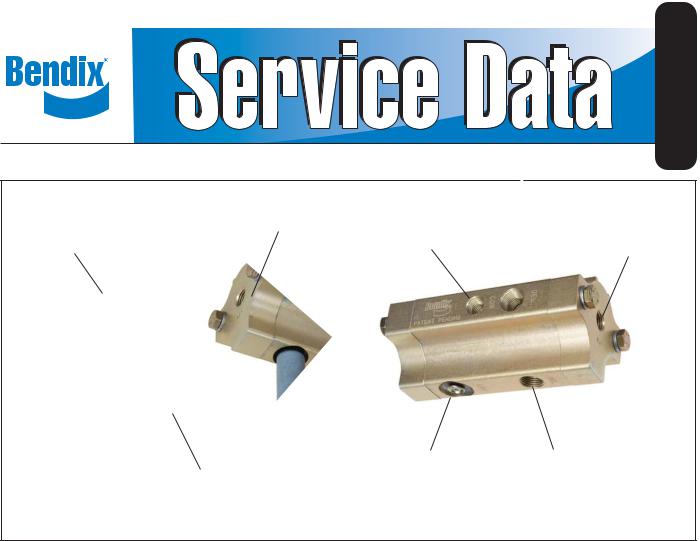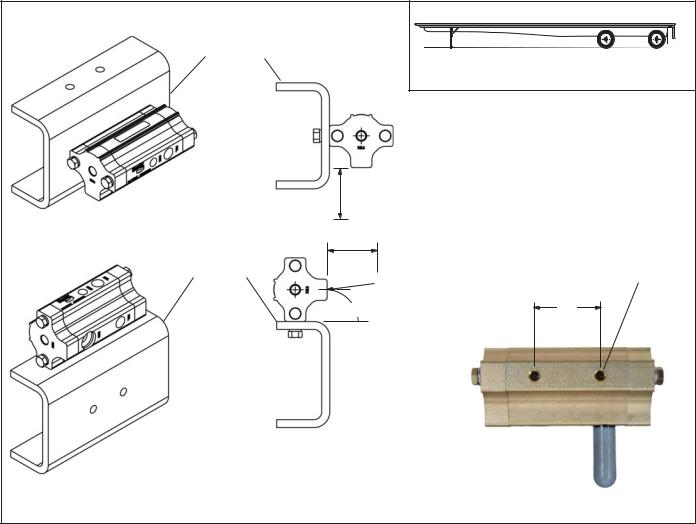BENDIX SD-03-4520 User Manual

|
|
|
SD-03-4520 |
Bendix® SDS-9600™ Trailer Suspension Dump Valve |
|
||
1/4" NPT |
3/8" NPT |
1/4" NPT |
|
DELIVERY PORT |
|
||
RESERVOIR |
CONTROL |
1/4" NPT |
|
PORT |
|
PORT |
|
|
SUPPLY PORT |
||
|
|
|
|
|
EXHAUST PORT |
3/8" NPT |
EXHAUST PORT |
SHOWN WITH |
DELIVERY PORT |
DIAPHRAGM |
|
|
SHOWN WITH |
|
|
|
|
|
OPTIONAL SILENCER |
|
|
FIGURE 1 - BENDIX® SDS-9600™ TRAILER SUSPENSION DUMP VALVE PORT IDENTIFICATION
DESCRIPTION
The SDS-9600™ trailer suspension dump valve is utilized on spread axle trailers, to negotiate tight turns at low speeds by limiting torsion forces on the rear trailer axle. These forces can damage tires, frames, and suspension components.
When activated, the SDS-9600™ trailer suspension dump valve exhausts (dumps) a portion of the air out of the rear trailer axle suspension taking the weight off of that axle, and transferring it to the forward trailer axle. The trailer can then pivot on the forward trailer axle in a turn.
Maintaining a portion of the air in the rear axle reduces damage to the air suspension, saves on suspension and system air, reduces time needed to re-inflate the system when required, and reduces tire chattering, all of which may occur if all of the air is exhausted from the suspension. The SDS-9600™ trailer suspension dump valve then returns air to the rear axle suspension upon driver input (deactivated) or when vehicle speed is in excess of 10 mph.
The Bendix® SDS-9600™ trailer suspension dump valve is a pilot operated normally open three-way valve with a high-capacity exhaust, inversion control, and delivery pressure hold feature. The function of the valve is to apply delivery pressure to the rear axle of a spread axle trailer suspension, and then to exhaust the delivery pressure through a high-capacity exhaust upon the input of a control signal. Upon exhaust, an internal mechanism of the trailer suspension dump valve stops the exhausting of air and holds the delivery pressure at a minimal pressure.
Porting is as follows:
•(2) 3/8 inch NPT delivery ports
•(1) 1/4 inch NPT control port
•(1) 1/4 inch NPT supply port
•(1) 1/4 inch NPT reservoir
•(1) Exhaust port with Diaphragm or optional 3/8 inch NPT port
1

FRAME RAIL
FRAME RAIL
|
SPREAD AXLE TRAILER |
|
2" MINIMUM |
|
|
CLEARANCE |
|
|
2" MINIMUM |
3/8"-16 X .50 |
|
CLEARANCE |
||
MOUNTING |
||
|
||
EXHAUST |
HOLES (2) |
|
|
||
90° MAXIMUM |
2" |
FIGURE 2 - MOUNTING THE SDS-9600™ TRAILER SUSPENSION DUMP VALVE
OPERATION
MOUNTING ORIENTATION
The SDS-9600™ trailer suspension dump valve is mounted to the trailer frame rail or cross-member. It is preferred that the valve be mounted on the backside of a cross-member with the exhaust port facing down. Mounting on the top side of a cross-member is acceptable, providing the exhaust port is facing rearward on the vehicle. Never mount the valve with the exhaust port facing upwards. The valve should have at least 2 inches of clearance between the exhaust port and any other surface. Refer to Figure 2.
PREVENTIVE MAINTENANCE
Important: The SDS-9600™ trailer suspension dump valve is not serviceable, but must be inspected for proper operation as a part of routine vehicle maintenance.
No two vehicles operate under identical conditions, as a result, maintenance intervals may vary. Experience is a valuable guide in determining the best maintenance interval for air brake system components. At a minimum,
the SDS-9600™ valve should be inspected every 6 months or 1500 operating hours, whichever comes first, for proper operation. Should it not meet the elements of the operational tests noted in this document, further investigation and replacement of the valve may be required.
REMOVAL
Secure the vehicle with spring brakes or blocks. Drain the reservoir which supplies the SDS-9600™ valve. Mark and disconnect the connecting air lines. Remove the screws that secure the valve to the trailer frame rail. Remove the valve.
INSTALLATION
Typical system schematics for the SDS-9600™ valve are shown in Figures 3 and 4.
Inspect the mounting hardware and replace if necessary. Check connecting air lines for integrity and foreign material, replace if necessary. Re-connect the air lines. Check the operation of the valve by charging the system and performing the service check as described in this manual.
2
